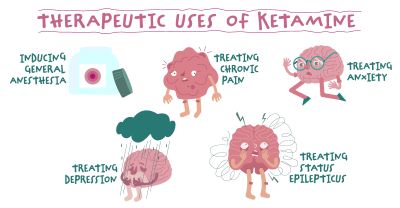Chronic pain affects millions worldwide, limiting daily activities and reducing quality of life. Pain management is complex and involves physical, emotional, and neurological factors. Opioids were once the main treatment for severe pain but carry serious risks. In recent years, alternatives have gained attention. One promising option is ketamine. Originally used as an anesthetic, it has shown potential for managing acute and chronic pain.
Contents
What Is Ketamine?
Ketamine is a dissociative anesthetic widely used in both human and veterinary medicine. It works by disrupting certain brain functions, causing sedation and a sense of detachment. It is most commonly administered intravenously or through intramuscular injection to induce anesthesia during surgery.
Beyond its anesthetic properties, ketamine influences several receptor systems in the brain. This complex mechanism has expanded its applications, including its use as an alternative to conventional pain medication. Some formulations are now approved for treating resistant depression as well, indicating its broader potential in treating neurological and psychological conditions.
While ketamine can help manage chronic pain, it does carry risks. These include potential side effects such as hallucinations, elevated blood pressure, and dizziness. Treatment should be administered in a controlled setting under the supervision of medical professionals experienced in its use.
How Does It Alleviate Pain?
Ketamine’s pain-relieving effects stem from its action on various pathways in the nervous system. Its primary mechanism involves blocking NMDA (N-methyl-D-aspartate) receptors. These receptors are responsible for interpreting pain signals and transmitting them to the brain. By inhibiting these receptors, it reduces the intensity of pain signals reaching the central nervous system.
One unique aspect of ketamine is its ability to disrupt “pain memory” in the brain. Chronic pain often involves the central nervous system amplifying pain signals, even after the initial injury has healed. It can help reset these processes by modifying how the brain processes and remembers pain, offering hope for people with long-standing conditions.
Ketamine produces rapid effects compared to conventional medications. While pain relief can take days or weeks with standard treatments, ketamine often provides noticeable results in hours. This is particularly beneficial for acute pain or conditions requiring immediate relief.
What Conditions Is It Used For?
Ketamine has become a valuable tool in managing various hard-to-treat pain conditions. It is often used in settings where traditional treatments have been inadequate or when there is a need to avoid long-term opioid use. Common conditions treated with ketamine include:
- Neuropathic Pain
- Complex Regional Pain Syndrome (CRPS)
- Chronic Migraine
- Fibromyalgia
- Cancer-Related Pain
Ketamine is also utilized in cases of acute pain, such as post-operative recovery, burn injuries, and trauma. These applications emphasize its versatility in both short-term and long-term pain management. While it is not a first-line treatment for most conditions, its unique properties have made it an option for those with chronic or treatment-resistant pain. Its ability to target multiple systems in the body sets it apart from traditional pain medications, offering relief where other methods fall short.
Discover Smarter Pain Management
Understanding ketamine’s potential can help chronic pain sufferers make informed decisions about their treatment options. If you’re interested in exploring whether ketamine therapy is right for you, consult a qualified pain management specialist. They can guide you through the process, aligning your unique needs with treatment options. Chronic pain doesn’t have to define your life. Take your next step toward relief by discussing treatments with your healthcare provider.
